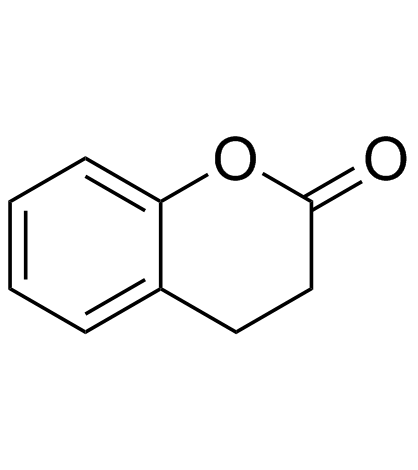Dihydrocoumarin

Dihydrocoumarin structure
|
Common Name | Dihydrocoumarin | ||
|---|---|---|---|---|
| CAS Number | 119-84-6 | Molecular Weight | 148.159 | |
| Density | 1.2±0.1 g/cm3 | Boiling Point | 272.0±15.0 °C at 760 mmHg | |
| Molecular Formula | C9H8O2 | Melting Point | 24-25 °C(lit.) | |
| MSDS | Chinese USA | Flash Point | 108.4±17.8 °C | |
| Symbol |

GHS07 |
Signal Word | Warning | |
|
Synthesis, carbonic anhydrase inhibition and cytotoxic activity of novel chromone-based sulfonamide derivatives.
Eur. J. Med. Chem. 96 , 425-35, (2015) Four series of sulfonamides incorporating chromone moieties were synthesized and assessed for their cytotoxic activity against MCF-7 and A-549 cell lines, considering the fact that some of these tumors overexpress isoforms of carbonic anhydrase (CA, EC 4.2.1.... |
|
|
DJ-1 interacts with and regulates paraoxonase-2, an enzyme critical for neuronal survival in response to oxidative stress.
PLoS ONE 9(9) , e106601, (2014) Loss-of-function mutations in DJ-1 (PARK7) gene account for about 1% of all familial Parkinson's disease (PD). While its physiological function(s) are not completely clear, DJ-1 protects neurons against oxidative stress in both in vitro and in vivo models of ... |
|
|
The effect of temperature on the catalytic conversion of Kraft lignin using near-critical water.
Bioresour. Technol. 170 , 196-203, (2014) The catalytic conversion of suspended LignoBoost Kraft lignin was performed in near-critical water using ZrO2/K2CO3 as the catalytic system and phenol as the co-solvent and char suppressing agent. The reaction temperature was varied from 290 to 370°C and its ... |
|
|
Characterization of the PON1 active site using modeling simulation, in relation to PON1 lactonase activity
Bioorg. Med. Chem. 16 , 7504-9, (2008) Paraoxonase1 (PON1) is a HDL bound enzyme and many of the anti-atherogenic properties of HDL are attributed to PON1. The enzyme precise mechanism of protective action and its endogenous substrate remain elusive. PON1 hydrolyzes organophosphates, arylesters an... |
|
|
Natural ingredients based cosmetics. Content of selected fragrance sensitizers.
Contact Dermatitis 34(6) , 423-6, (1996) In the present study, we have investigated 42 cosmetic products based on natural ingredients for content of 11 fragrance substances: geraniol, hydroxycitronellal, eugenol, isoeugenol, cinnamic aldehyde, cinnamic alcohol, alpha-amylcinnamic aldehyde, citral, c... |
|
|
Anticoagulant activity of some Artemisia dracunculus leaf extracts.
Bosn. J. Basic Med. Sci. 15 , 9-14, (2015) Platelet hyperactivity and platelet interaction with endothelial cells contribute to the development and progression of many cardiovascular diseases such as atherosclerosis and thrombosis. The impact of platelet activity with different pharmacological agents,... |
|
|
Synthesis and biological evaluation of α-methylidene-δ-lactones with 3,4-dihydrocoumarin skeleton.
Bioorg. Med. Chem. 20(16) , 5017-26, (2012) A series of new 3-methylidenechroman-2-ones bearing various aromatic moieties and various substituents at position 4 were synthesized in a three step reaction sequence. Friedel-Crafts alkylation of phenols or naphthols using ethyl 3-methoxy-2-diethoxyphosphor... |
|
|
Atom arrangement strategy for designing a turn-on 1H magnetic resonance probe: a dual activatable probe for multimodal detection of hypochlorite.
Chem. Commun. (Camb.) 48(10) , 1565-7, (2012) The first dual activatable hypochlorite ((-)OCl)-sensing probe was developed, based on a new proof-of-concept design involving signal-activatable (1)H chemical probes using the triple-resonance NMR technique. The probe enabled fluorescence-(1)H MR dual turn-o... |
|
|
Lack of evidence for allergenic properties of coumarin in a fragrance allergy mouse model.
Contact Dermatitis 57(6) , 361-4, (2007) There is controversy as to whether coumarin, an ingredient in cosmetics and fragrances, is a contact allergen involved in fragrance allergy. We recently showed that the purity of coumarin is a critical parameter for its allergenicity because coumarin preparat... |
|
|
A reinvestigation of the reaction of coumarins with superoxide in the liposomal bilayer: correlation between depth and reactivity.
Free Radic. Biol. Med. 49(10) , 1516-21, (2010) Afri et al. reported in this journal (Free Radic. Biol. Med.32:605-618; 2002) that a direct relationship exists between the depth of alkanoylcoumarins 1 within the liposomal lipid bilayer and the rate at which they undergo superoxide-mediated saponification. ... |